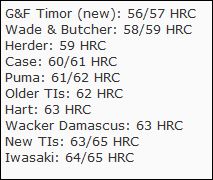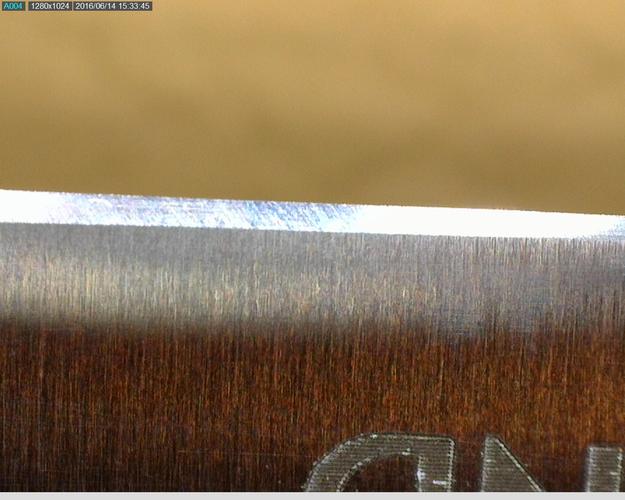Results 1 to 10 of 63
Hybrid View
-
02-21-2018, 10:22 AM #1

Wastilla from Finland, Pyrenees sandstone, a couple of Italian sandstones, there is a nice Spanish, Pedra das Meigas that works as well, Wallachian sandstone but it's hard to find, a quartzite stone that with slurry works nicely from the area Peter/hatzicho is from, a few from UK but they are really hard to find today... a couple of years ago I could remember some 20 different stones, now I'm a bit rusty.
I would not mention the Arkansas stones however, they are slow even for sharpening bronze.
Talking about slow, this is the reason we prefer the man made ones; the particles are a lot harder than the ones in natural stones, and thus cut steel a whole lot faster.
On naturals, it's pretty much silicon oxide, or some variation but with similar hardness, Mohs~7. On man made, it's AlOx or SiC Mohs 9 to 9++. It makes a huge difference, and the harder the steel, the bigger said difference on steel removal. Razors are made to be as hard as possible for steel, so, the natural stones for them is not the right way to go.
For finishers, it makes sense since the feeling of a natural stone can't be seen from pretty much any synthetic stone. On the lower spectrum of grit though, it's quite the opposite.
-
-
02-21-2018, 12:08 PM #2
-
02-21-2018, 12:28 PM #3

Natural finishers are still around because the edge is friendlier to our skin; the round shaped particles that finish our edges are different than most of the AlOx and SiC ones from the man made ones.
As for hardness, for the real razors, the softest start from 58RC and go up to 67 and even higher on some Iwasaki. You wouldn't call that soft, otherwise they would be made out of the "dreaded" 18/8 steel our spoons are made out of, and without the tempering. No hard feelings on that 18/8 steel, the spoons or the manufacturers, everything serves a purpose after all. But razors are different.
Edit; you don't need diamond hardness to refine an already well shaped edge, just to remove a few micrometers and refine the edge a bit further. On bevel setting on the other hand, you might even need to remove a whole millimeter. You can't exactly do that with a translucent Arkansas, or at least it will take enough time and elbow sweat, it will be a nightmare.Last edited by Vasilis; 02-21-2018 at 12:31 PM.
-
02-21-2018, 12:45 PM #4Senior Member

- Join Date
- Sep 2013
- Location
- NW Indiana
- Posts
- 1,060
Thanked: 246
I would like to see a reference (preferably with test methodology) regarding steel being hardened over 67 Rc. I have never heard of steel getting harder than about 66 Rc. Steel this hard would likely be nearly useless and very chippy.
-
02-21-2018, 12:56 PM #5

Carbon steel straight razors can be scratched pretty easy. They do not seem that hard to me. Also I wouldn't attempt to take a millimeter of steel off with the Translucent . Soft arkansas would me my choice.
-
02-21-2018, 01:12 PM #6Senior Member

- Join Date
- Sep 2013
- Location
- NW Indiana
- Posts
- 1,060
Thanked: 246
That would be very dependent on hardness. A razor at the top end of the scale would be as near as impervious to a natural bevel setting stone so as to be almost impossible to set a bevel with one. For a razor closer to 58/60 Rc it would not be that big of a deal.
-
02-21-2018, 01:24 PM #7

In truth, I have the same question. In fact, steel at 65RC, in a commercial scale would not only be impossible to make and sell, the sheer number of blades that would fail would be huge.
Here is an old photo I copied here from the forum on average hardness of razor manufacturers;

And the above chart is for western style razors, kamisori were going a bit higher still. I'm baffled on how but more importantly, why would anyone do that.
As for the "it's impossible to get steel harder than 66RC", it's simply not true; there is no law similar to absolute zero or speed of light; 1% carbon, correct heat treatment, quench, temper, dip in liquid Helium to maximize martensite formation & voila! You can do it yourself, with enough money, practice and patience. As for being chippy, I'm sure you are right, that thing would be more like cermet than steel. I haven't tested such a piece although I do hope to.
I'm not saying that I have seen, or verified its existence. Only that at some point I read about it, and thought "holy mother of God, how was that done and why?"
We have some very capable blacksmiths, quite possibly some of the best of our age here in the forum who know their stuff, usually in the "forge" section. I enjoy reading about their accomplishments, you can say they are the "astronauts" who walk the moon, I'm the lowly "astrologist" watching from afar.
-
The Following User Says Thank You to Vasilis For This Useful Post:
Substance (02-21-2018)
-
02-21-2018, 04:44 PM #8

There's a Turkish sandstone from Bolu, just south of the Black Sea, known as a "Bolu" stone. I haven't used it with razors; but a couple of summers ago, I gave one to a friend in France, and we found that it works well for starting the edges of kitchen knives and generates lots of swarf. Pretty even feel that might translate well to razors. Used with olive oil.
Last edited by Brontosaurus; 02-21-2018 at 04:47 PM.
Striving to be brief, I become obscure. --Horace
-
The Following User Says Thank You to Brontosaurus For This Useful Post:
Vasilis (02-22-2018)
-
02-21-2018, 06:39 PM #9Senior Member

- Join Date
- Sep 2013
- Location
- NW Indiana
- Posts
- 1,060
Thanked: 246
-
02-21-2018, 06:43 PM #10

I got the chart from Neil Miller, may he rest in peace. I doubt you'll find a person who double checked his data more than him, I've been in many occasions where I assumed something only to be scolded by him for not being able to verify my thoughts' kind of like what's happening here. Anyway, the above chart is as legitimate as can be, for that I'm sure.
Edit; eKretz, if you have different information, or any of the above measurements are different from yours being a toolmaker, please share your knowledge. That's what this forum is for, and I meant no disrespect, naturally. It's the opposite in fact.Last edited by Vasilis; 02-21-2018 at 06:48 PM.


 50Likes
50Likes LinkBack URL
LinkBack URL About LinkBacks
About LinkBacks






 Reply With Quote
Reply With Quote

